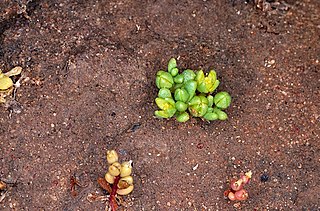
Amaranthaceae is a family of flowering plants commonly known as the amaranth family, in reference to its type genus Amaranthus. It includes the former goosefoot family Chenopodiaceae and contains about 165 genera and 2,040 species, making it the most species-rich lineage within its parent order, Caryophyllales.

The Salicornioideae are a subfamily of the flowering plant family Amaranthaceae. Important characters are succulent, often articulated stems, strongly reduced leaves, and flowers aggregated in thick, dense spike-shaped thyrses. These halophytic plants are distributed worldwide. Many are edible

The Gomphrenoideae are a subfamily of the Amaranthaceae.

Ochnaceae is a family of flowering plants in the order Malpighiales. In the APG III system of classification of flowering plants, Ochnaceae is defined broadly, to include about 550 species, and encompasses what some taxonomists have treated as the separate families Medusagynaceae and Quiinaceae. In a phylogenetic study that was published in 2014, Ochnaceae was recognized in the broad sense, but two works published after APG III have accepted the small families Medusagynaceae and Quiinaceae. These have not been accepted by APG IV (2016).
Neoscortechinia is a plant genus of the family Euphorbiaceae first described as a genus in 1897. It is native to Southeast Asia and Papuasia.
- Neoscortechinia angustifolia(Airy Shaw) Welzen - Sabah, Kalimantan
- Neoscortechinia forbesii(Hook.f.) S.Moore - New Guinea, Admiralty Islands, Bismarck Archipelago, Solomon Islands
- Neoscortechinia kingii(Hook.f.) Pax & K.Hoffm. - W Malaysia, Sumatra, Borneo
- Neoscortechinia nicobarica(Hook.f.) Pax & K.Hoffm. - Nicobar Islands, Myanmar, Malaysia, Indonesia, Philippines, W New Guinea
- Neoscortechinia philippinensis(Merr.) Welzen - Myanmar, Thailand, Malaysia, W Indonesia, Philippines
- Neoscortechinia sumatrensisS.Moore - W Malaysia, N. Sumatra, Simeuluë, Borneo

Heinrich Gustav Adolf Engler was a German botanist. He is notable for his work on plant taxonomy and phytogeography, such as Die natürlichen Pflanzenfamilien, edited with Karl A. E. von Prantl.

Abrophyllum is a monotypic genus of flowering plants in the family Saxifragaceae sensu lato according to Engler, A. in Engler & Prantl and Schulze-Menz, G. K. in Melchior, 1964; placed in Subfamily Escallonioideae, Tribe Cuttsieae, it is closely related to Cuttsia. In the APG II system Abrophyllum is placed in family Rousseaceae.
One of the prime systems of plant taxonomy, the Engler system was devised by Adolf Engler (1844–1930), and is featured in two major taxonomic texts he authored or co-authored. His influence is reflected in the use of the terms "Engler School" and "Engler Era". Engler's starting point was that of Eichler who had been the first to use phylogenetic principles, although Engler himself did not think that he was.

Die Natürlichen Pflanzenfamilien is a botanical work in German language, first published in many volumes between 1887–1915 and written by Adolf Engler (1844–1930) and Karl Anton Prantl (1849–1893). It contained a complete revision of plant families down to generic level and often even further. As such it forms part of the Engler system of plant taxonomy.

Karl Anton Eugen Prantl, also known as Carl Anton Eugen Prantl, was a German botanist.

Sarcomelicope is a genus of about ten species of flowering plants in the family Rutaceae that are endemic to the South Pacific.

Rosularia is a small genus of the family Crassulaceae. It includes about 28-35 species from Europe, the Himalayas, and northern Africa.

Cardiopteridaceae is a eudicot family of flowering plants. It consists of about 43 species of trees, shrubs, and woody vines, mostly of the tropics, but with a few in temperate regions. It contains six genera, the largest of which is Citronella, with 21 species. The other genera are much smaller.

The Betoideae are a small subfamily of the flowering plant amaranth family, Amaranthaceae sensu lato. Commonly known members include beet, sugar beet, chard, and mangelwurzel, which all are cultivars of Beta vulgaris.

The Polycnemoideae are a small subfamily of plants in the family Amaranthaceae, representing a basal evolutionary lineage. The few relictual species are distributed in Eurasia and North Africa, North America, and Australia.

The Suaedoideae are a subfamily of plants in the family Amaranthaceae.
Oskar Eberhard Ulbrich was a German botanist and mycologist.

The Lilioideae are a subfamily of monocotyledonous perennial, herbaceous mainly bulbous flowering plants in the lily family, Liliaceae. They are found predominantly in the temperate and colder regions of the Northern Hemisphere, particularly East Asia and North America. The subfamily includes two tribes. They are of economic importance, particularly the lilies and tulips.

Haemanthinae is a small subtribe of Haemantheae, and therefore within the African clades of Amaryllidoideae. It consists of two genera, Haemanthus, and Scadoxus.

Gunniopsis septifraga, commonly known as green pigface, is a species of flowering plant in the iceplant family, Aizoaceae and is endemic to Australia. It is a prostrate to tuft-forming annual herb, with oblong to lance-shaped leaves and small greenish flowers, that grows around salt lakes.

















